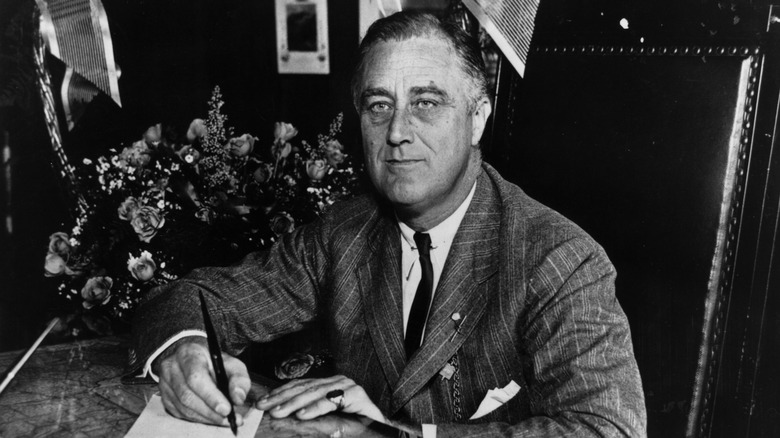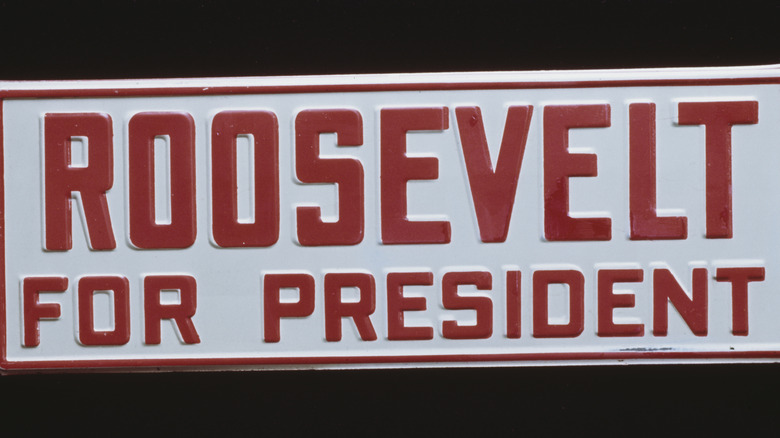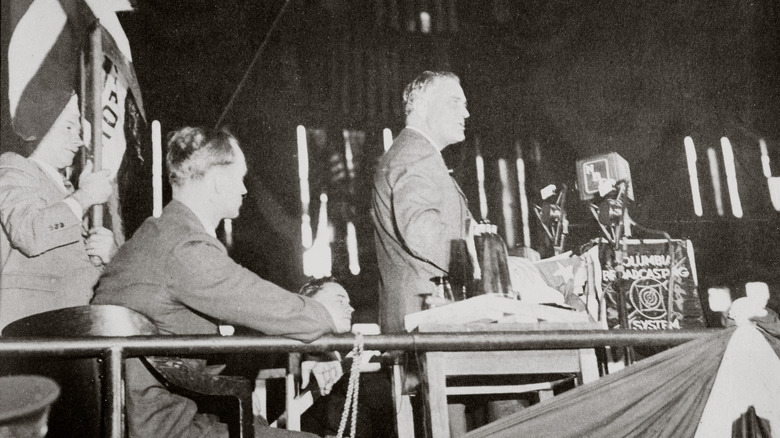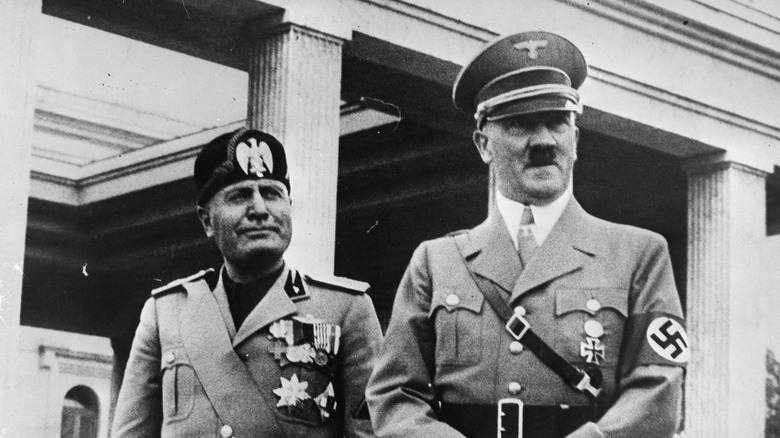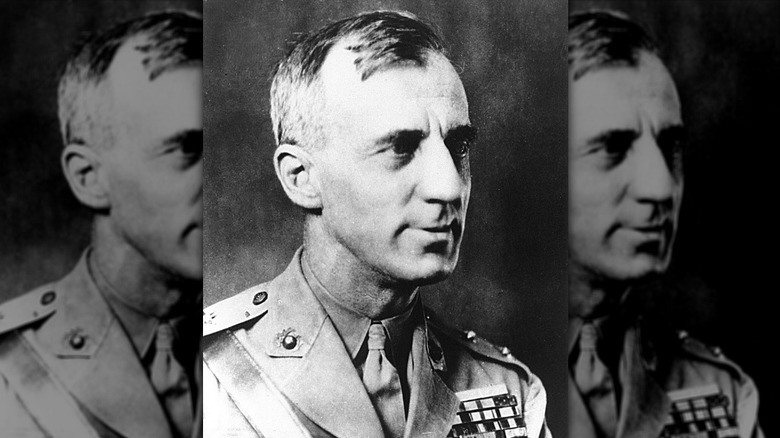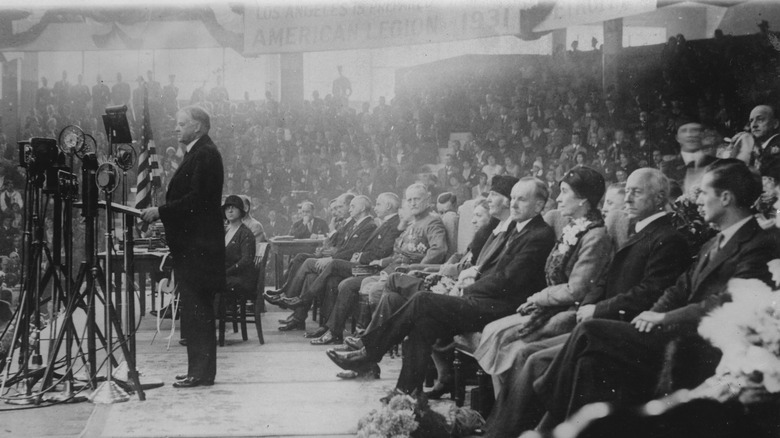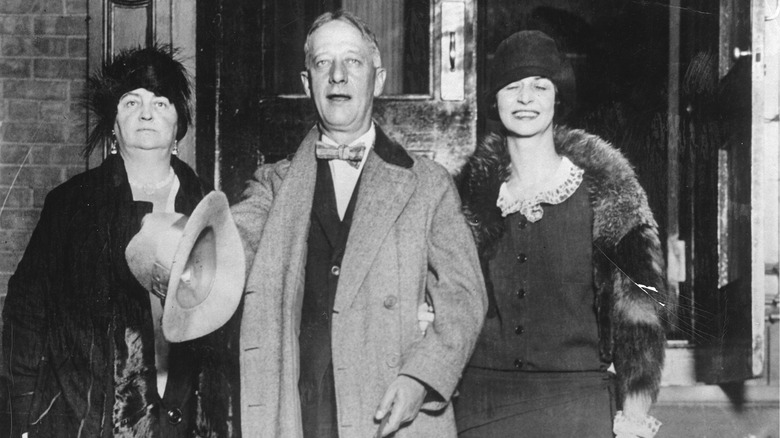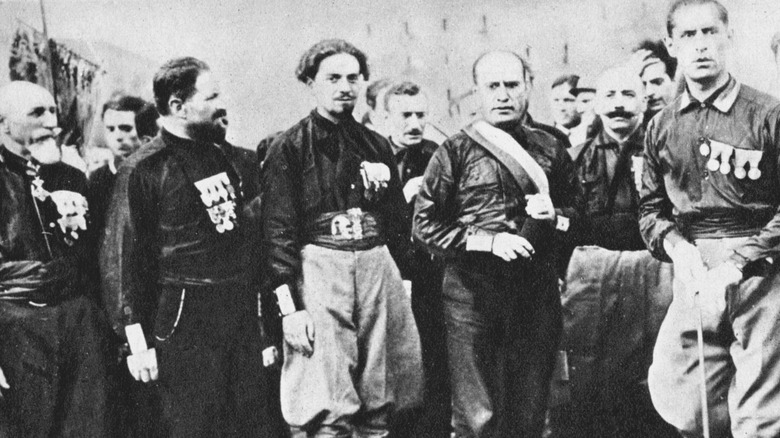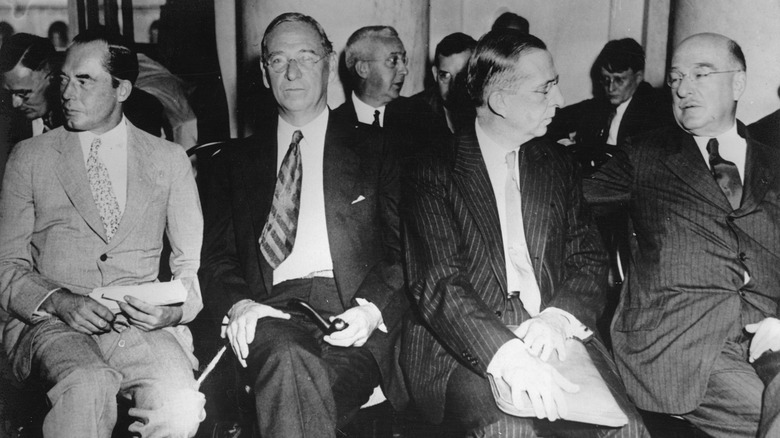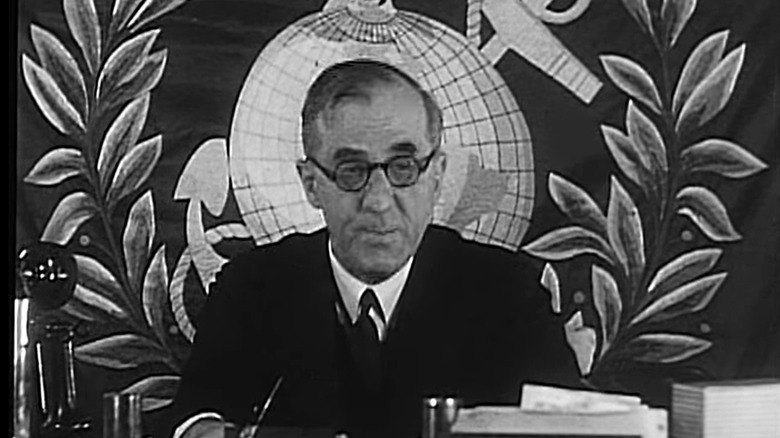The 1933 Business Plot They Didn't Teach You About In School
The last few years of the American political scene have seen a fierce debate in America over the influence of corporations, debt currency, and insurrection (via New York Times). But none of it has come to an serious, deliberate attempt to overthrow the government in recent years. But in the 1930s, America was in a similar state of political ferment and economic distress. During the Great Depression, President Franklin Delano Roosevelt won the 1932 election and continued a series of controversial reforms begun under his predecessor Herbert Hoover to try and alleviate the crushing unemployment and poverty that had swept the nation.
But his reforms were not popular with everyone. America's elite decided that Roosevelt, a former member of their Old Boys' club, was messing with their wealth a little too much and had to be removed. Thus, they decided to emulate Europe's totalitarian dictators and seize the state through a proxy general. America had not faced a coup attempt since 1783 Newburgh Conspiracy, and it is unclear just how far this plot went. But it was a plot that involved the who's-who of high American society. Here is the story of the bizarre plot to turn America totalitarian.
The election of 1932
The origins of the Business Plot of 1933-'34 go back to 1929. That year on Black Tuesday (October 29), a massive stock market crash sent the United States into the Great Depression. When matters did not resolve by 1931-1932, President Herbert Hoover was facing criticism over his actions to curb the depression. Facing him was fresh-faced Democrat Franklin Delano Roosevelt, who promised to do things a bit differently from Hoover. Just not in the way one might expect.
Contrary to the popular narrative, Roosevelt ran on what today would be considered a fiscally conservative platform, according to the FDR Presidential Library. He promised to cut government spending to rein in Hoover's $3 billion deficit, balance the budget, and according to the Tax History Project, not repeat Hoover's 1932 tax increase. This was in response to Hoover's economic interventionism, contrary to the narrative that he was a do-nothing president that left Americans to starve. As University of St. Lawrence economics professor Stever Horwitz argued (via Economics Library), Hoover attempted his own sort of New Deal, inserting the federal government in a U.S. economy that historically had embraced laissez-faire capitalism relatively free from government intervention. As his policies — mainly attempts to raise wages in times of deflation — worsened unemployment and businesses bled jobs, Hoover's chances of reelection plummeted.
The results of the 1932 election were a foregone conclusion. Roosevelt crushed Hoover in a 45-state landslide, winning 472 electoral votes (via 270towin). Hoover only won 59, 36 of them from Pennsylvania. It would now be seen if Roosevelt would be any different than his predecessor.
FDR's economic platform
Once inaugurated in 1933, Franklin D. Roosevelt entered the famous "100 Days" of his presidency. According to the FDR Presidential Library, he jettisoned his conservative fiscal policy and turned half-heartedly to Keynesianist deficit spending. Thus, the United States would take on more debt to encourage consumption, which would keep money circulating in the economy. Although privately favoring a balanced budget (via Tax History Project), America's 25% unemployment rate led him to embrace interventionism. Doing otherwise, per the FDR Library, was "a crime against the American people."
Thus, Roosevelt began a massive expansion of the federal bureaucracy that dwarfed his predecessor's attempt, although it came nowhere close to the spending seen these days. The two most important acts for the purposes of the Business Plot (via History) paid farmers to reduce agricultural output and forced unionized businesses to fix their wages above market level. The effects of these bills are hotly debated. Loyola University economics professor Thomas DiLorenzo (via the Mises Institute) argues that the National Industrial Recovery Act forced businesses to pay higher wages than they could afford, which led to layoffs, while economists Greg Hannsgen and Dimitri Papadimitriou of Bard's Levy Institute have argued that the bill might have helped American workers survive hard times. But for America's capitalist class, the bills were a disaster. Not only did the regulations cut into their profits, Roosevelt threatened their hard money as well.
The gold confiscation of 1933
America's wealthiest were already concerned with possible "soak the rich" taxes. Newspaper tycoon William Randolph Hearst called them "despotic" and "discriminatory." But the increase in taxes was not the main reason for the conspiracy to remove Franklin Roosevelt from office. Many of the new taxes, in fact, did not kick in until 1935. For America's wealthy, especially sectors of the banking establishment, no policy irked them more than Roosevelt's 1933 gold confiscation under EO 6102.
EO 6102 is one of Roosevelt's less-known yet most controversial executive orders. The order ordered all Americans to surrender all gold bullion (aka coins) and gold certificates over $100 to their nearest Federal Reserve bank or Federal Reserve System branch. Private ownership of gold was banned outside of a few exceptions. Americans, according to Investopedia, were "compensated" at $20.67 an ounce with intrinsically worthless Federal Reserve Notes (aka dollar bills). Once the gold was confiscated, the U.S. Treasury increased the price of gold to $35. Not only did this cheat Americans out of about $15, it also increased the Treasury's dollar holdings by $2.81 million that could be used to fund New Deal programs
Timeline notes that America's wealthiest, the banking class, had the most to lose from the gold confiscation. None wanted to have their bank loans repaid with Federal Reserve debt notes that could be devalued through printing. But instead of fighting what they deemed to be Roosevelt's "dictatorship" in Washington, a section of the American elite decided to replace him with one of their own.
Sympathy for fascism
America's elite class looked across the sea towards Europe for ideas on how to fight Franklin D. Roosevelt, who had empowered unions to their detriment and was now confiscating their hard money. According to socialist magazine Liberation School, the American elite was concerned with America's leftward turn. The magazine argues that Roosevelt's policies emboldened American socialists, who engineered a series of labor strikes in the early 1930's. They were inspired by the rising power of the Soviet Union, which the U.S. recognized in 1933. While the role of Soviet recognition is suspect, since capitalists such as Henry Ford had no problem doing business there (via History), it is likely that labor agitation at home did threaten profits. So, the American elite looked to two regimes that had eradicated organized labor: Adolf Hitler's Germany and Benito Mussolini's Italy.
Fascist Europe, whose most salient feature was the marriage of corporations with the state, was attractive to America's corporate elite (despite their socialist origins). According to economist Lawrence Samuels, Hitler and Mussolini had been incredibly successful at union busting, placing Italian and German corporations in the driver's seat with state sponsorship. These corporations wielded enormous power within their respective governments, often with financial partnerships with America's corporate elite. Fascist Europe's biggest financial supporters were Henry Ford, Prescott Bush (President G.W. Bush's grandfather), the DuPont family, and John D. Rockefeller, who, for business and eugenics interests, supported these regimes.
The key man: Smedley Butler
In 1933, not even a year into the Roosevelt Administration's first term, the corporate class allegedly began plotting to remove Franklin Roosevelt from office. With a focus on "allegedly," because the entire story of the plot rested upon the testimony of a single man, Marine Corps general Smedley Butler, whom the plotters selected to lead the coup. First, a little background is in order.
According to the USMC, General Butler was a true American patriot, Medal of Honor recipient, pacifist, and vehement opponent of America's capitalist elite. Best described as a constitutionalist firmly dedicated to the Bill of Rights, the American corporate foreign ventures thoroughly disturbed the general. His philosophy was simple: "War is a Racket. It always has been." Poor men fight, rich men profit. A 1933 speech explained that his career had been spent as an enforcer for corporate interests abroad. This clashed with his non-interventionist beliefs and America's profiteering elites (regardless of political loyalties), whom he accused of financing numerous 20th-century conflicts. He loathed European fascism, saving his worst criticisms for Italy's Benito Mussolini.
It is strange that the corporate and banking classes behind the Business Plot should have turned to a man who referred to them as parasitic war profiteers. But the plotters saw Butler's patriotism and love of the United States as something they could exploit, especially since Butler had clashed with the U.S. government in 1932.
The Bonus Army incident
Smedley Butler's choice as the leader of the plot is strange indeed. According to Arcadia Publishing, Butler came from a line of Republican politicians and had even run for Congress in 1932 as a Republican in Pennsylvania. But he broke with the Hoover Administration after a fiasco called the Bonus Army, which struck a nerve with the general, who had always been a strong supporter of veterans' rights.
According to the National Park Service, a 1924 U.S. government promise to pay bonuses to World War I veterans was still unpaid by 1932. In response, U.S. veterans camped out in Washington, D.C., in protest, demanding the money they had earned through risking their lives on Europe's battlefields. When Congress finally pushed a bill through to pay the bonuses and disperse the "Bonus Army," Hoover vetoed it. Instead, the president violently dispersed the mob, which was referred to as a collection of "tramps" after rumors that communist infiltrators had worked their way into the crowd.
According to NPR, Butler was enraged, and rightly so. First, the men in 1918 had been considered heroes, while now, when they were an inconvenience, they were "tramps." He had spoken before the Bonus Army urging it not to give up until the Congress paid what was owed. According to the book "Maverick Marine," Butler allied himself with Franklin Roosevelt's campaign to depose Hoover. He cared little for Roosevelt's political leanings, but thought he might make a good president, presumably based on his 1932 campaign platform.
The alleged plot
The main movers of the plot, according to Smedley Butler's testimony to the McCormack-Dickstein Committee (via libertariansism.org) were Bill Doyle and Gerald MacGuire, higher-ranking America Legion members from New England. They invited Butler to speak at the legion's national convention in Chicago. Butler knew he had not been invited, and MacGuire and Doyle claimed he had actually been disinvited (by the president himself). But it did not matter. They offered to enter him as Hawai'i's representative, despite the obvious problem that Butler did not live there. Butler was to take 300 legionnaires to the convention, all paid for by MacGuire, who had somewhere between $42,000-$64,000 (more than $1 million today) at his disposal from various American Legion donors. These donors would become instrumental to the plot later.
To Butler, the whole thing was suspicious. Even more so when the two movers told him that they already had a speech prepared for him about veterans' benefits. The speech was not as subversive as presented. It urged the government to honor its commitments to veterans' benefits. But it called for the benefits to be paid in gold, not "rubber money or paper money," a reference to Roosevelt's confiscation under EO 6102. The average veteran, Butler responded, did not understand the importance of the gold standard. Thus, they were pawns in MacGuire and his bosses' political games. Butler ultimately refused to go despite offers of the plot movers to pay his mortgage and any other debts.
The offer
This is where things got interesting. Although the plot is associated with conservative elements in American society, the man that was to get it going was none other than 1928 Democratic presidential nominee Al Smith (above). According to Smedley Butler's testimony (via libertarianism.org), Gerald MacGuire told the general that Smith, an old ally of Franklin Roosevelt, had split with him over the gold confiscation. He was prepared to wreck Roosevelt's reputation among veterans through an organization called the American Liberty League. However, no one would find him convincing unless Butler supported him. While Smith handled the PR, Butler was to "go around and talk to the soldiers" to gauge their willingness "to join a great big super organization to maintain the democracy."
Here, MacGuire reframed what was quickly becoming a plot against the executive branch. Suddenly, he cared for Roosevelt. "The president is overworked," he claimed. He needed a break. Naturally, this did not compute, as MacGuire had just discussed annihilating Roosevelt's reputation among veterans. Finally, MacGuire revealed the true scope of the plans. MacGuire (or his handlers) stated their concerns that much of the money in circulation that was used to pay working Americans and veterans was in government bonds. In other words, people were getting paid with IOU's, not actual money, a legitimate grievance against Roosevelt's administration. Thus, (via libertarianism.org) Butler was to assemble 500,000 men, march on D.C., and force Roosevelt to put him in power. Keynesian debt-financing could not be allowed to become the U.S. government's main way of financing itself. The "dumb American people," meanwhile, would go along.
The European sojourn
While Gerald MacGuire's offer to Smedley Butler was concerning enough, a nine-month trip to Europe tipped Butler off to the plot's real objective (via libertarianism.org). MacGuire told Butler that he had taken a nine-month vacation to Europe. But it had not been purely a pleasure trip. Among the places McGuire visited were Italy, Germany, France, and possibly the USSR. While he admired Benito Mussolini, Adolf Hitler, and Joseph Stalin's use of the armed forces to buttress their power, he was aware that the American public would never tolerate any sort of military rule. So in France, McGuire observed how right-wing veterans' organizations had been able to wield political power and decided to try that in America.
According to MacGuire, since veterans already occupied a respected place in the public's imagination, their participation was the key to doing to Franklin D. Roosevelt "what Mussolini [had done] with the king of Italy." This was a reference to the famous 1922 March on Rome that put Mussolini in power (above). Butler was to repeat that feat. No one would oppose an army of veterans demanding their benefits, and if Roosevelt would not cooperate, they would surely remove him. But the veterans were just an excuse. According to the congressional release (via libertarianism.org), MacGuire thought that Roosevelt had fallen under communist influence. A fascist government was needed to save the America and prevent communism from tearing everything down as it had in the USSR. But ideology generally comes in second to power and ambition. As expected, there were much more powerful people pulling MacGuire's strings.
The real plotters revealed
Smedley Butler's testimony focused on Gerald MacGuire and Bill Doyle, but they were not the main plotters. While they were ideologically motivated, the real movers were likely powerful people who cared little for political ideologies or -isms. The identities of this shadowy cabal can be deduced through their connections to two suspects named in the congressional record (via libertarianism.org) that did not testify: J.P Morgan & Co. executive Thomas Lamont and John W. Davis, founding member of the influential Council of Foreign Relations, and Rockefeller Foundation trustee since 1922. Through their positions, Davis and Lamont were linked to some of America's most powerful bankers and industrialists, who financed Al Smith's American Liberty League.
A pamphlet published by American labor activist Grace Hutchins revealed the ALL's powerful backers, for whom Davis and Lamont were likely fronts. They included men such as Irenee DuPont (above), John D. Rockefeller (who was still alive) and his Rockefeller Foundation, Alfred P. Sloan, Howard Pew, Howard Heinz, and a raft of J.P. Morgan & Co. bankers. It is unlikely that these men were ignorant of the ALL's plans to remove Franklin Roosevelt, but nothing has ever been proven in court. Interestingly, Prescott Bush, the father and grandfather of two U.S. presidents, was not named, but given his Union Banking Corporation involvement in stashing German gold in the U.S. (via The Guardian) through Adolf Hitler ally Fritz Thyssen, he likely knew of the plot (via GWU). As Timeline puts it, Roosevelt had messed with their gold and their banks. Now, they were going to mess with his presidency.
And then, nothing happened
Smedley Butler's testimony was for naught. According to Harper's Magazine, not one single alleged conspirator was called to testify, let alone arrested, tried, or imprisoned. The National Archives quickly scrubbed all records of the Committee (which are difficult to find even now) and the alleged perpetrators' links to totalitarian regimes in Europe, which continued into World War II. MacGuire denied all knowledge of the plot (via libertarianism.org), while the actual plotters — those who had financed the American Liberty League — were left untouched. Today their names are associated with respected organizations such as Heinz Ketchup, the Alfred P. Sloan Foundation, DuPont Chemical, or Pew Research. Prescott Bush became a Connecticut senator while his descendants became presidents. This would have never been possible without the complicity of the media, which went into full cover-up mode.
According to Tablet Magazine, the New York Times, owned by the controversial Ochs-Sulzberger family, had just run a 1933 cover up the Soviet Holodomor genocide against Ukrainians. As soon as the Business Plot surfaced, the paper did it again: In a 1934 article, the paper argued that Butler's testimony did not "lend verisimilitude to an otherwise bald and unconvincing narrative." It was, for lack of a better way of describing it, a gigantic hoax. And so, the only modern plot to overthrow the U.S. government vanished into the wind just as quickly as it had come. So completely was it scrubbed from public conscience, that most Americans are completely unaware of it today.
